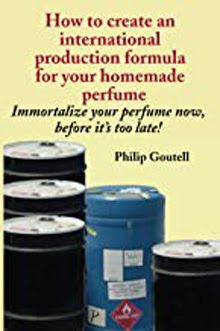Monday, September 6, 2021
Technology for small scale perfume production
I've just published a book called Making Perfume By The Quart: A do-it-yourself project book. It's now available on Amazon. It has occupied most of my time during the months of July and August.
The point of this book is simple. If you want to make your own perfume, your own brand with your own chosen name on the bottle -- on any scale -- getting started by making just one quart teaches you almost all of what you need to know to make 10,000 bottles or more. The advantages of getting started by making just one quart rather than 10,000 bottles are that (1) you can do it for pocket change and (2) you don't have to submit your idea to a committee or investors and, if you mess up, no one has to know.
To me this makes a lot of sense and, along the way, I've met more than one person who should have tried doing a quart before jumping in with both feet and ending up with Christmas presents for the next few centuries. Disclaimer here: the first time I got involved with perfume we gave away a lot of unsold perfume at Christmas... and every other holiday for a number of years!
The wonderful thing about writing a book is that you learn a lot along the way. You think you know something -- and you did, ten years ago -- but now there are changes. The most dramatic change has been the access to everything you need, in the U.S., through the internet. (Elsewhere there can be issues with alcohol and labeling.)
One of the coming changes is in spray pump technology. In the book I tell readers they can only use screw-on pumps with matching threaded neck bottles -- and this is still about 98 percent true. But last week I capped a perfume bottles with a snap-on spray pump using a capper tool I got through an English source, Plush Folly. It worked very nicely and gave the bottle a much lower profile than it would have had with either a screw-on or a crimp-on pump.
Bottles for snap-on pumps are easily available in the U.S. because they are the same bottles that take crimp-on pumps and crimp-on pumps are still the industry standard. But, in the U.S., snap-on pumps are hard to find. I can't name a single source. However, I have discovered several Chinese sources that will take small orders. Shipping time and cost from Chinese vendors has become quite reasonable so for me, snap-on pumps are the way forward.
One more issue on my mind today -- continuity. Using the new capper tool I bottled the last of a fragrance which both my wife and I like. I want to produce more and have the formula along with the sources for each required material. But some of the natural materials were from a company no longer in business. That's a problem.
No doubt I can find replacements for the resins but for certain I'll have to do some testing and adjusting. When it comes to natural materials, what you buy from one source can have very different characteristics than that what you might buy from another, even though both sell it under the same name.
For perfumers the source of any natural material is very important for the effect of say oil from roses grown on one side of a hill might be quite different than the effect of oil from roses grown on the other side of the hill. Soil, water, sunshine, temperature, altitude all make for differences.
This is something to ab aware of when developing your own fragrances. On the other hand, synthetic materials of the same CAS (chemical abstracts service) number should be identical and interchangeable, regardless of source.
So these are my thoughts that I wanted to share with you today.
Thank you for your patience!
-- Phil
Subscribe to:
Post Comments (Atom)


No comments:
Post a Comment